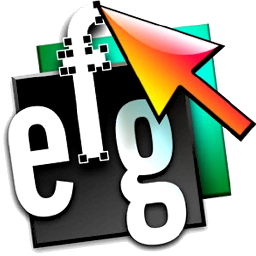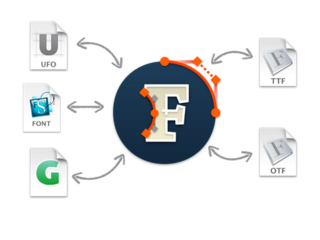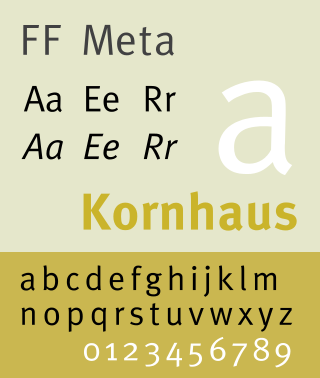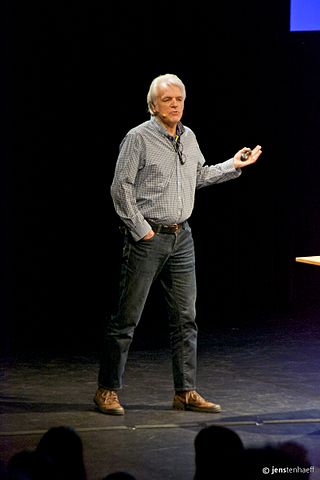Related Research Articles

A glyph is any kind of purposeful mark. In typography, a glyph is "the specific shape, design, or representation of a character". It is a particular graphical representation, in a particular typeface, of an element of written language. A grapheme, or part of a grapheme, or sometimes several graphemes in combination can be represented by a glyph.

A typeface is a design of letters, numbers and other symbols, to be used in printing or for electronic display. Most typefaces include variations in size, weight, slope, width, and so on. Each of these variations of the typeface is a font.
OpenType is a format for scalable computer fonts. Derived from TrueType, it retains TrueType's basic structure but adds many intricate data structures for describing typographic behavior. OpenType is a registered trademark of Microsoft Corporation.

Fontographer is a font editor for Windows and macOS; it is used to create digital fonts. It was originally developed by Altsys but is now owned by FontLab Ltd.
A computer font is implemented as a digital data file containing a set of graphically related glyphs. A computer font is designed and created using a font editor. A computer font specifically designed for the computer screen, and not for printing, is a screen font.

There are Unicode typefaces which are open-source and designed to contain glyphs of all Unicode characters, or at least a broad selection of Unicode scripts. There are also numerous projects aimed at providing only a certain script, such as the Arabeyes Arabic font. The advantage of targeting only some scripts with a font was that certain Unicode characters should be rendered differently depending on which language they are used in, and that a font that only includes the characters a certain user needs will be much smaller in file size compared to one with many glyphs. Unicode fonts in modern formats such as OpenType can in theory cover multiple languages by including multiple glyphs per character, though very few actually cover more than one language's forms of the unified Han characters.

FontForge is a FOSS font editor which supports many common font formats. Developed primarily by George Williams until 2012, FontForge is free software and is distributed under a mix of the GNU General Public License Version 3 and the 3-clause BSD license. It is available for operating systems including Linux, Windows, and macOS, and is localized into 12 languages.

Cambria is a transitional serif typeface commissioned by Microsoft and distributed with Windows and Office. It was designed by Dutch typeface designer Jelle Bosma in 2004, with input from Steve Matteson and Robin Nicholas. It is intended as a serif font that is suitable for body text, that is very readable printed small or displayed on a low-resolution screen and has even spacing and proportions.

Consolas is a monospaced typeface designed by Luc(as) de Groot. It is a part of the ClearType Font Collection, a suite of fonts that take advantage of Microsoft's ClearType font rendering technology. It has been included with Windows since Windows Vista, Microsoft Office 2007 and Microsoft Visual Studio 2010, and is available for download from Microsoft. It is the only standard Windows Vista font with a slash through the zero character. It is the default font for Microsoft Notepad as of Windows 8.

Constantia is a serif typeface designed by John Hudson and commissioned by Microsoft. It is a transitional serif design, influenced by Eric Gill’s Perpetua design. Development of the typeface began in 2003 and it was released in 2006.

FontLab is a font editor developed by Fontlab Ltd. FontLab is available for Windows and macOS.

Linux Libertine is a digital typeface created by the Libertine Open Fonts Project, which aims to create free and open alternatives to proprietary typefaces such as Times New Roman. It was developed with the free font editor FontForge and is licensed under the GNU General Public License and the SIL Open Font License.

FF Meta is a humanist sans-serif typeface family designed by Erik Spiekermann and released in 1991 through his FontFont library.
A font editor is a class of application software specifically designed to create or modify font files. Font editors differ greatly depending on if they are designed to edit bitmap fonts or outline fonts. Most modern font editors deal with the outline fonts. Bitmap fonts uses an older technology and are most commonly used in console applications. The bitmap font editors were usually very specialized, as each computing platform had its own font format. One subcategory of bitmap fonts is text mode fonts.
FontShop International was an international manufacturer of digital typefaces (fonts), based in Berlin. It was one of the largest digital type foundries.
The Web Open Font Format (WOFF) is a font format for use in web pages. WOFF files are OpenType or TrueType fonts, with format-specific compression applied and additional XML metadata added. The two primary goals are first to distinguish font files intended for use as web fonts from fonts files intended for use in desktop applications via local installation, and second to reduce web font latency when fonts are transferred from a server to a client over a network connection.

Adobe Systems, Inc. v. Southern Software, Inc. was a case in the United States District Court for the Northern District of California regarding the copyrightability of digitized typefaces. The case is notable since typeface designs in general are not protected under United States copyright law, as determined in Eltra Corp. v. Ringer. Since that case, the United States Copyright Office has published policy decisions acknowledging the registration of computer programs that generate typefaces. In this case, the court held that Adobe's Utopia font was protectable under copyright and Southern Software, Inc.'s Veracity font was substantially similar and infringing.

Erik van Blokland is a Dutch typeface designer, educator and computer programmer. He is the head of the Type Media Master of Design program in Typeface Design at the Royal Academy of Art, The Hague in the Netherlands.

Petr van Blokland is a Dutch graphic designer, software author and typeface designer who lives in Delft.
Just van Rossum is a Dutch typeface designer, software developer, and professor at the Royal Academy of Art in the Hague. He is the co-founder of design firm, LettError, along with Erik van Blokland. Just van Rossum is the younger brother of Guido van Rossum, creator of the Python programming language.
References
- 1 2 "Contributors". unifiedfontobject.org. Archived from the original on 2021-11-05. Retrieved 2021-11-05.
- 1 2 "Overview". unifiedfontobject.org. Archived from the original on 2021-11-05. Retrieved 2021-11-05.
- 1 2 3 4 5 "RoboFab Release History". 2008-10-04. Archived from the original on 2008-10-04. Retrieved 2022-02-21.
- 1 2 3 4 5 6 7 8 9 10 11 12 13 Arista, Roberto (Autumn 2016). "RoboTools: L'influenza dell'open source sugli strumenti di produzione del carattere tipografico" [RoboTools: The influence of open source on typeface production tools]. Progetto Grafico 30 (in Italian and English). AIAP Edizioni: 33–39.
- 1 2 3 4 Middendorp, Jan (2004). Dutch type. Rotterdam: 010 Publishers. p. 187. ISBN 90-6450-460-1. OCLC 54880333.
- 1 2 3 4 5 Kiel, Ben (May 4, 2005). "An Introduction to RoboFab". Typographica. Archived from the original on 2022-02-15. Retrieved 2022-02-21.
- ↑ Siracusa, John (2001-04-02). "Mac OS X 10.0". Ars Technica. Archived from the original on 2022-02-21. Retrieved 2022-02-21.
- ↑ "UFO 2". unifiedfontobject.org. Archived from the original on 2020-10-19. Retrieved 2022-02-21.
- 1 2 Peter Bilak; François Rappo; Pierre Keller (2010). Typeface as program : applied research and development in typography = Le caractère typographique comme programme : recherche appliquée et développement en typographie. Lausanne, Switzerland: École cantonale d'art de Lausanne. ISBN 978-3-03764-072-2. OCLC 630189661.
- 1 2 RoboFont. "The history of RoboFont". robofont.com. Archived from the original on 2022-01-26. Retrieved 2022-02-21.
- 1 2 3 4 5 6 7 "Robothon 2012, RoboHint, and the Gerrit Noordzij Prize". Typographica. Retrieved 2022-02-14.
- 1 2 "UFO 3". unifiedfontobject.org. Archived from the original on 2022-01-20. Retrieved 2022-02-21.
- 1 2 "Working with UFO | Glyphs". glyphsapp.com. Archived from the original on 2021-11-05. Retrieved 2021-11-05.
- 1 2 "Font Formats". help.fontlab.com. Archived from the original on 2021-11-05. Retrieved 2021-11-05.
- 1 2 "Technical Bulletin: UFO 3 Export". fontforge.org. Archived from the original on 2021-11-05. Retrieved 2021-11-05.
- ↑ "UFO 4". unifiedfontobject.org. Archived from the original on 2022-02-21. Retrieved 2022-02-21.
- 1 2 3 4 5 6 7 8 9 10 11 12 13 "Font Development Best Practices: UFO". silnrsi.github.io. Archived from the original on 2022-02-22. Retrieved 2022-02-22.
- ↑ "Glyph Interchange Format". unifiedfontobject.org. Retrieved 2022-02-14.
- ↑ "UFO: Unified Font Object". luc.devroye.org. Retrieved 2022-02-14.
- ↑ "features.fea". unifiedfontobject.org. Archived from the original on 2020-10-18. Retrieved 2022-02-21.
- ↑ Simonson, Mark (2014-06-12). "I didn't quite realize until recently: .ufo + Dropbox kind of sucks". @marksimonson. Retrieved 2020-05-28.
- ↑ Leming, Tal, ufonormalizer: Script to normalize the XML and other data inside of a UFO. , retrieved 2022-02-22
- ↑ "FontCreator features and benefits". www.high-logic.com. Retrieved 2022-09-23.
- ↑ Willis, Nathan (2014-12-08). "A quick look at the new FontForge release [LWN.net]". lwn.net. Archived from the original on 2022-02-21. Retrieved 2022-02-21.
- ↑ Willis, Nathan. "Font and type development at LGM 2014". lwn.net. Archived from the original on 2022-02-21. Retrieved 2022-02-21.
- ↑ "Metapolator – Free Font Editor for Designing Typeface Families". metapolator.com. Retrieved 2022-02-21.
- ↑ RoboFont. "Welcome to RoboFont!". robofont.com. Archived from the original on 2021-11-05. Retrieved 2022-02-21.
- ↑ Willis, Nathan (April 27, 2016). "Introducing TruFont [LWN.net]". LWN.net. Archived from the original on 2018-11-23. Retrieved 2022-02-21.
- 1 2 "LWN.net Weekly Edition for August 29, 2013 [LWN.net]". lwn.net. Archived from the original on 2021-11-05. Retrieved 2021-11-05.
- ↑ "Cooper Hewitt: the typeface by Chester Jenkins | Cooper Hewitt, Smithsonian Design Museum". www.cooperhewitt.org. 2014-06-13. Retrieved 2022-02-21.
- ↑ "Inisiatif Google Melestarikan Bahasa Terancam Punah Lewat Noto Font". liputan6.com (in Indonesian). 2020-11-25. Retrieved 2021-11-05.
- ↑ "Open Baskerville". klepas.org. Archived from the original on 2022-01-02. Retrieved 2022-02-22.
- ↑ Beckmann, Tom; Justus Hildebrand; Corinna Jaschek; Eva Krebs; Alexander Löser; Marcel Taeumel; Tobias Pape; Lasse Fister; Robert Hirschfeld (2019). The font engineering platform collaborative font creation in a self-supporting programming environment. Potsdam: Universitätsverlag Potsdam. p. 72. ISBN 978-3-86956-464-7. OCLC 1169672607.